Order these records by:
Browse Collection › LC Subject Heading › 34 records found where LC Subject Heading is Tobacco industry -- North Carolina -- Durham -- 19th century | ||
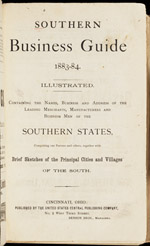 | Southern business guide, Section of the 1883-84 Southern Business Guide containing the personal names, business names, and street addresses of the leading merchants, manufacturers, and businessmen of Durham, North Carolina. Also provides a summary of Durham's history and railroad lines. The guide lists 71 businesses and their locations. | |
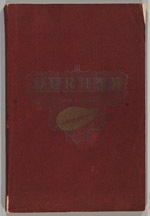 | Hand-book of Durham, North Carolina : a brief and accurate description of a prosperous and growing southern manufacturing town This pocket-sized handbook documents the people, businesses, social conditions, and government of Durham, North Carolina, and compares Durham's industrial and social advantages to other cities of the same size. It includes statistical records and information about Durham's government, health, real estate, taxes, buildings, streets, waterworks, fire departments, electric lights and gas, telephones, hotels, hospitals, markets, schools and colleges, churches, lodges, and social clubs. Included are lithographs of Mangum Street and Main Street and depictions of prominent buildings, such as: Bennett Place; Durham County Court House; the Fire House; Hotel Carolina; City Hospital; Durham Graded School; Trinity College's Main Building; Trinity Methodist Church; Main Street Methodist Church; the Presbyterian Church; the First and Second Baptist Church; bank buildings; the factory of the Blackwell Durham Tobacco Co.; Duke Tobacco Factory; and textile factories. Portraits include Isaac N. Link, ma... | |
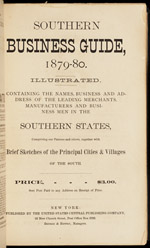 | Southern Business Guide (Excerpt) This section of the Southern Business Guide 1879-1880 contains the names of the leading merchants, manufacturers, and entrepreneurs of Durham, North Carolina. The guide lists, in alphabetical order, 54 businesses. Includes listings for businesses on Main Street as well as W. Duke, Sons and Company, Atlas Rigsbee's General Store, R. H. Wright & Company and W. T. Blackwell & Company. | |
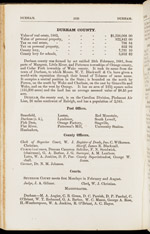 | North Carolina state directory and gazetteer, 1883-84 (Excerpt) Section of Chataigne's 1883-1884 gazetteer listing the names of merchants, business owners, and tradesmen in Durham County, categorized by occupation. The directory also provides information about public officials and the location of post offices. | |
 | Chas. Emerson’s North Carolina tobacco belt directory 1886 (Excerpt) This excerpt from the 1886 directory lists Durham County's land owners. Each entry includes the landowner's name, the location of the nearest post office, and the number of acres the individual owned. Individuals with African American heritage are denoted by an asterisk (*). The directory identifies 16 post offices in Chapel Hill, Dayton, Durham, Fish Dam, Flat River, Hillsboro, Kunkadora, Luster, Lyndover, McCown, Morrisville, Mount Tirzah, Orange Factory, Red Mountain, Staggville, and South Lowel. Advertisers include John L. Markham; Robertson, Lloyd and Co.; and the Durham Recorder. | |
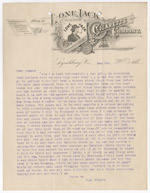 | Letter from Richard Harvey Wright to Thomas D. Wright, May 09, 1887 With anticipation of rising prices of tobacco cutters, Richard Wright advises his brother Thomas Wright to buy out Reed & McGees tobacco stock. In sharing family news, Richard writes that his daughter "Little May is I think improving." | |
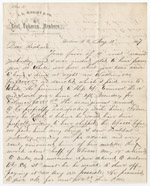 | Letter from Thomas D. Wright to Richard Harvey Wright, August 11, 1887 Thomas Wright highlights notable developments in the tobacco market; E. J. Parrish has announced his plans to rebuild his tobacco warehouse. Thomas also shares family news: Richard's daughter, Little May is improving. Thomas also comments on his own health. | |
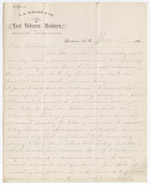 | Letter from Thomas D. Wright to Richard Harvey Wright, January 09, 1888 Thomas Wright has a gloomy outlook on his upcoming trip to Richmond in an effort to procure more tobacco. He thinks it's folly for a man to speculate in tobacco unless he has $25,000 in capital. He wants to try a different approach but needs advice and cash from his brother, Richard Harvey Wright. He asks Richard to consider helping him purchase land from Tilly. | |
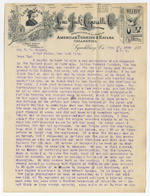 | Letter from A. T. Powell to Richard Harvey Wright, January 17, 1889 A. T. Powell, secretary and treasurer of the Lone Jack Cigarette Company in Durham, North Carolina, describes a gruesome industrial accident that caused the death of a child in the Lynchburg cigarette factory. He notes that the Coroner called the death accidental. | |
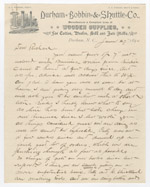 | Letter from Thomas D. Wright to Richard Harvey Wright, June 27, 1890 Thomas D. Wright, updates his brother, Richard Harvey Wright, on the fiscal situation at the Durham Bobbin and Shuttle Company. He also describes the emergence of new business ventures in Durham--The Farmers' Alliance tobacco plug factory and general excitement about a possible future cotton factory. | |
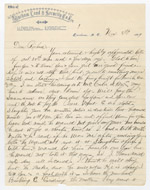 | Letter from Robert I. Rogers to Richard Harvey Wright, November 08, 1889 Robert I. Rogers shares news about real estate in Durham, the rise in tobacco prices and the upcoming meeting of Blackwell's creditors. He also comments on the smaller turn out for the evangelical preacher Sam Jones, who held his revival in Durham. | |
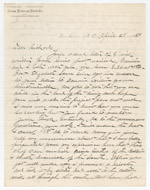 | Letter from Thomas D. Wright to Richard Harvey Wright, April 29, 1889 Thomas Wright shares a detailed report of the Durham Bobbin & Shuttle Mills's accounts and operations with his brother Richard Wright. | |
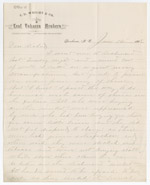 | Letter from Thomas D. Wright to Richard Harvey Wright, January 16, 1888 Thomas Wright tells his brother, Richard Harvey Wright, about his inability to sell his firm's tobacco in the Richmond market. Thomas observes that Durham-grown tobacco costs 25% more than the tobacco offered by Richmond tobacco brokers. | |
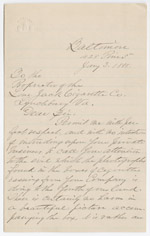 | Letter from John T. Wightman to Richard Harvey Wright, January 03, 1888 Baltimore clergyman, John T. Wightman, expresses his disapproval about the photographs packaged in cigarette boxes and the evil the cigarette cards are doing to youth. Wightman begs Richard Harvey Wright to end the packaging of "vile pictures" in Lone Jack cigarettes. | |
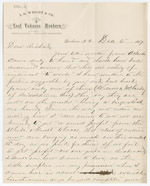 | Letter from Thomas D. Wright to Richard Harvey Wright, December 6, 1887 In this letter to his brother Richard, Thomas Wright, proprietor of the tobacco brokerage T. D. Wright and Company, shares the challenges which he faces in the tobacco market. He also notes that Mrs. Stokes lost both of her conjoined twins after their birth. | |
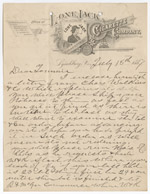 | Letter from Richard Harvey Wright to Thomas D. Wright, July 18, 1887 Writing on Lone Jack Cigarette Company stationary, Richard Harvey Wright directs his brother, Thomas, how to prize, package, and ship tobacco for the Charles Watkins & Company. | |
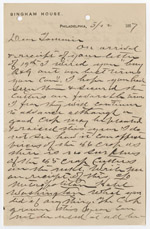 | Letter from Richard Harvey Wright to Thomas D. Wright, May 22, 1887 In this letter, Richard discusses the conditions of the tobacco crop and chastizes his brother for not heeding his previous advice to buy out "R & G on best terms you can." | |
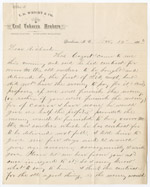 | Letter from Thomas D. Wright to Richard Harvey Wright, November 19, 1886 Thomas Wright seeks advice from his brother, Richard Harvey Wright, on a business proposal offered by Thomas Cozart. Mr. Cozart wants to buy and deliver 10000 lbs of "old smokers," but lacks cash. Cozart offers the Wright Brothers half of the profits if they will contribute cash. Thomas mentions a fire that burnt an entire block between Mangum and Church streets and nearly reached the Methodist church. | |
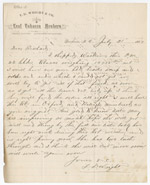 | Letter from Thomas D. Wright to Richard Harvey Wright, July 21, 1887 Thomas blends family and business news in this letter to his brother, Richard Harvey Wright. He has just shipped roughly 20,000 pounds of tobacco to one customer. He tells Richard that his daughter May is sick and expresses hope that she will feel well by fall. He describes his own daughter who had also been ill as plump and teething. | |
 | Letter from Thomas D. Wright to Richard Harvey Wright, July 24, 1890 Thomas Wright explains that the presents of silver have been sent to Mrs. Annie E. Snow and she is expected to forward to Mrs. Edmundson.He also discusses orders at the Durham Bobbin and Shuttle Co. | |
 | Letter from Richard Harvey Wright to George W. Moore, Jr., January 19, 1889 Richard Harvey Wright asks George Moore,Jr. to cease selling shares relating to his Bonsack machine enterprise. Wright explains "it is good stock & no machine yet made or under way can compete with it." | |
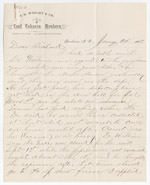 | Letter from Thomas D. Wright to Richard Harvey Wright, January 24, 1889 Thomas D. Wright updates his brother, Richard Harvey Wright, on Durham business news and the health of Mamie Richard's daughter. The child has just recovered from mumps. | |
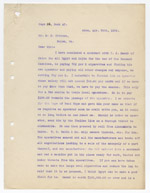 | Letter from Richard Harvey Wright to D.B. Strouse, April 19, 1889 Richard Harvey Wright sends a report to D. B. Strouse, President of the Bonsack Machine Company in which he describes his recent conversations with E. J. Manuk, a British subject and tobacco merchant living in Egypt. Wright explains the terms of the contract that will enable Manuk to use the Bonsack machine for cigarette production. | |
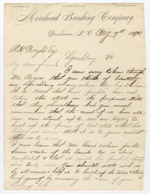 | Letter from William M. Morgan to Richard Harvey Wright, August 07, 1890 William M. Morgan expresses disappointment in Richard Harvey Wright's plans to settle in Lynchburg, Virginia, rather than Durham, North Carolina. In discussing the local economy, Morgan mentions Julian S. Carr's real estate scheme. | |
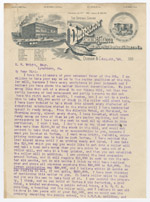 | Letter from Julian S. Carr to Richard Harvey Wright, August 06, 1890 Julian S. Carr, President of Durham Smoking Tobacco and Blackwell's Durham Tobacco Co., gives Richard Harvey Wright his vision to develop Durham and make more money. | |
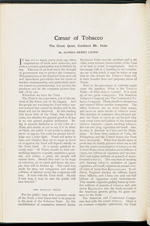 | Caesar of tobacco : the great, quiet, confident Mr. Duke Biographical portrait of James Buchanan Duke, with a focus on his leadership role in the American Tobacco Company and the Continental Tobacco Company. | |
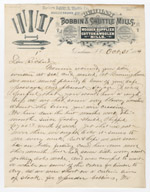 | Letter from Thomas D. Wright to Richard Harvey Wright, October 31, 1889 Thomas D. Wright shares details of the Durham Bobbin and Shuttle Mill's sales report and the condition of its 40 employees. He refers to Tom Jones's death, to religion, and to a visit from Methodist preacher Sam Jones. | |
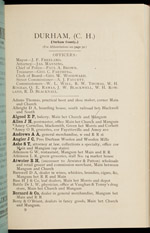 | Chas. Emerson’s North Carolina tobacco belt directory 1886 (Excerpt) This section of Emerson's 1886 directory lists businesses within the corporate limits of the town of Durham.The directory lists the names of proprietors, stores' locations and the products sold. Individuals with African American heritage are denoted by an asterisk (*). | |
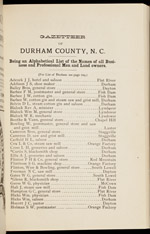 | Chas. Emerson’s North Carolina tobacco belt directory 1886 (Excerpt) This section of the 1886 directory entitled, Gazetteer of Durham County, North Carolina, lists 70 Durham County merchants and land owners, together with the name of the post office located nearest their businesses. Individuals with African American heritage are denoted by an asterisk (*). Occupations include hotel and saloon keeper, shoe maker, general store keeper and grocer, postmaster, mechanic and blacksmith, minister and pastor, saw and grist mill owner, physician, and cotton ginner. | |
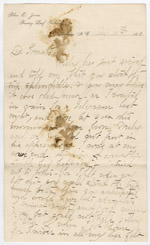 | Letter from Mattie Logan Southgate Jones to Thomas Decatur Jones, August 10, 1889 Mattie Southgate Jones writes her husband Thomas Decatur Jones conveying her happiness that he arrived at his destination safely. She reports that their son Decatur slept fitfully and continues to talk "insesently" about his absent father. She details her domestic chores and forwards news from A.S. DeVlarming, her husband's bookkeeper, about the Jones tobacco enterprise. She notes that the local newspaper, the Sun, published a lengthy personal about Thomas. She closes with a request that Thomas send news through his correspondence. | |
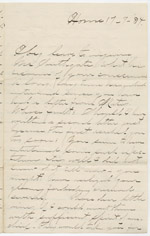 | Letter from Kate Christine Sanborn to James Southgate , July 17, 1884 Kate Christine Sanborn tells James Southgate, that she has heard rumors that his daughter Mattie is spending time with a buyer of bright leaf tobacco. She wants Mattie's father to reveal the identity of this man who keeps her friend "in the parlor till 1 a.m. three nights a week." Kate comments on the nomination of Grover Cleveland and the placement of Thomas A. Hendricks on the Democratic ticket. She notes that the Durham papers have suggested that the younger James Southgate might be a suitable legislative candidate. She closes with a discussion of her unmarried status. | |
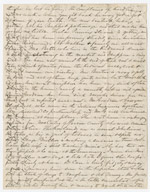 | Letter from James Southgate to Mattie Logan Southgate Jones, circa 1885 In this fragment of a letter, James Southgate takes his daughter on an imaginary walking tour of Durham where he visits with her friends, neighbors and town luminaries. Southgate reports on the news and gossip of the day: Durham's tobacco entrepreneurs, Blackwell & Goodson dissolved their partnership, Dr. A.G. Carr sold his stock of medicines to the druggists Vaughan & Tenny, Mrs. Battle struggles while her husband Dr. Lee W. Battle seeks treatment for his opium habit at the Asylum, and the Lehman family purchases a new piano. Additionally, Southgate supplies his daughter with tidbits of news concerning the Halliburton, Lyon, Smith, Perry, Phillips, Lockhart, Watts, Howerton, Farthing, Angier, McCabe, Thomas, Walker, Betts, Burton, Cooper, Rowland, Miller, Fuller, Gammon, Hopkins, Day, Mohsberg, Levy, Fawcett, Wilkerson, and Dalby families. | |
 | Letter from James Southgate to Mattie Logan Southgate Jones, circa 1885 In this fragment of a letter, James Southgate takes his daughter on an imaginary walking tour of Durham where he visits with her friends, neighbors and town luminaries. Southgate reports on the news and gossip of the day: Durham's tobacco entrepreneurs, Blackwell & Goodson dissolved their partnership, Dr. A.G. Carr sold his stock of medicines to the druggists Vaughan & Tenny, Mrs. Battle struggles while her husband Dr. Lee W. Battle seeks treatment for his opium habit at the Asylum, and the Lehman family purchases a new piano. Additionally, Southgate supplies his daughter with tidbits of news concerning the Halliburton, Lyon, Smith, Perry, Phillips, Lockhart, Watts, Howerton, Farthing, Angier, McCabe, Thomas, Walker, Betts, Burton, Cooper, Rowland, Miller, Fuller, Gammon, Hopkins, Day, Mohsberg, Levy, Fawcett, Wilkerson, and Dalby families. | |
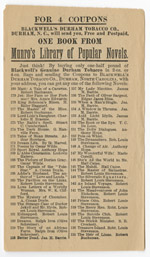 | Blackwell's Durham Telegraph: dime novel promotion In the late 1890s, Blackwell's Durham Telegraph offered consumers of Genuine Bull Durham Smoking Tobacco free popular literature from Munro's Library of Popular Novels in exchange for coupons from their tobacco products. This catalogue describes the promotion and lists the titles available. | |
digitaldurham@duke.edu · About this site · Copyright © 2001 - 2006. Trudi J. Abel. All Rights Reserved.
The copyright interest in the material in this digital collection has not been transferred to the Digital Durham project. These text and images may not be used for any commercial purpose without the permission of the David M. Rubenstein Rare Book & Manuscript Library and the Digital Durham Project. Copyright permission for subsequent uses is the responsibility of the user.
